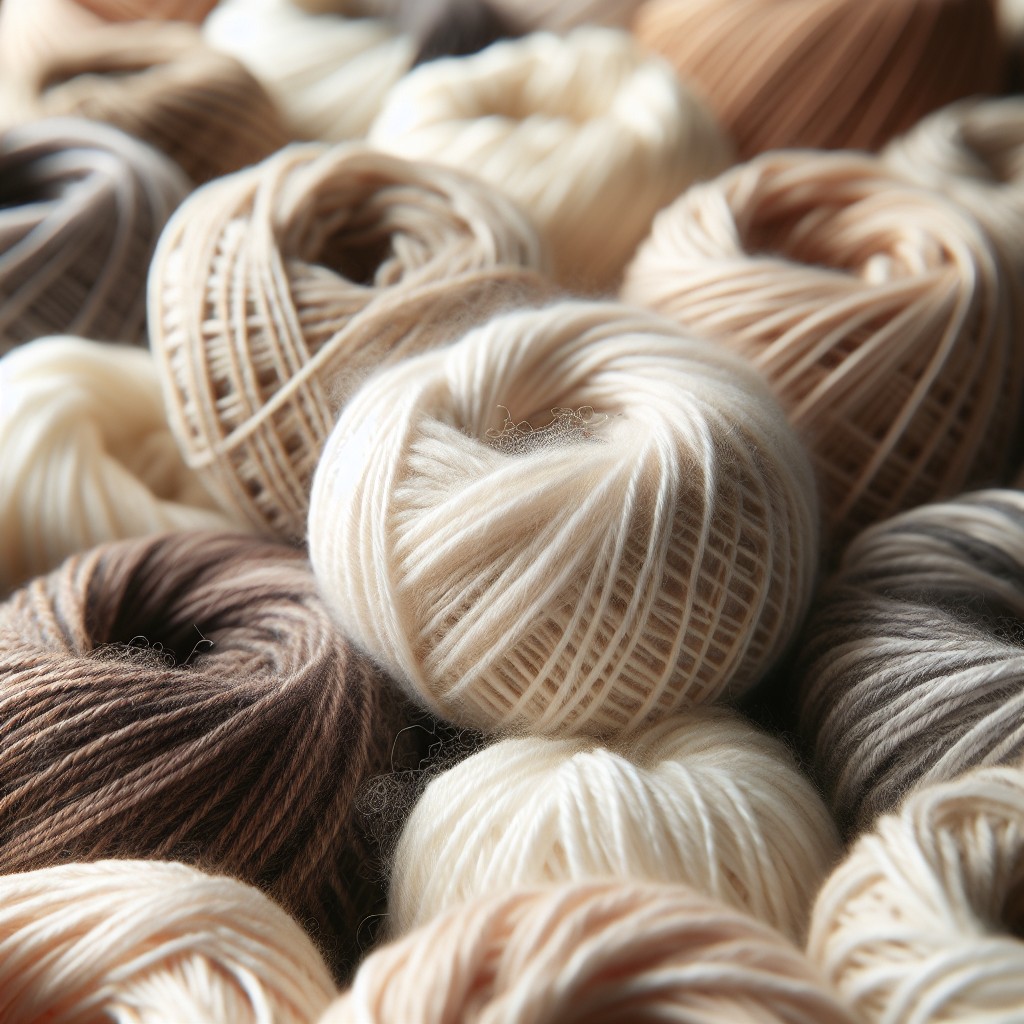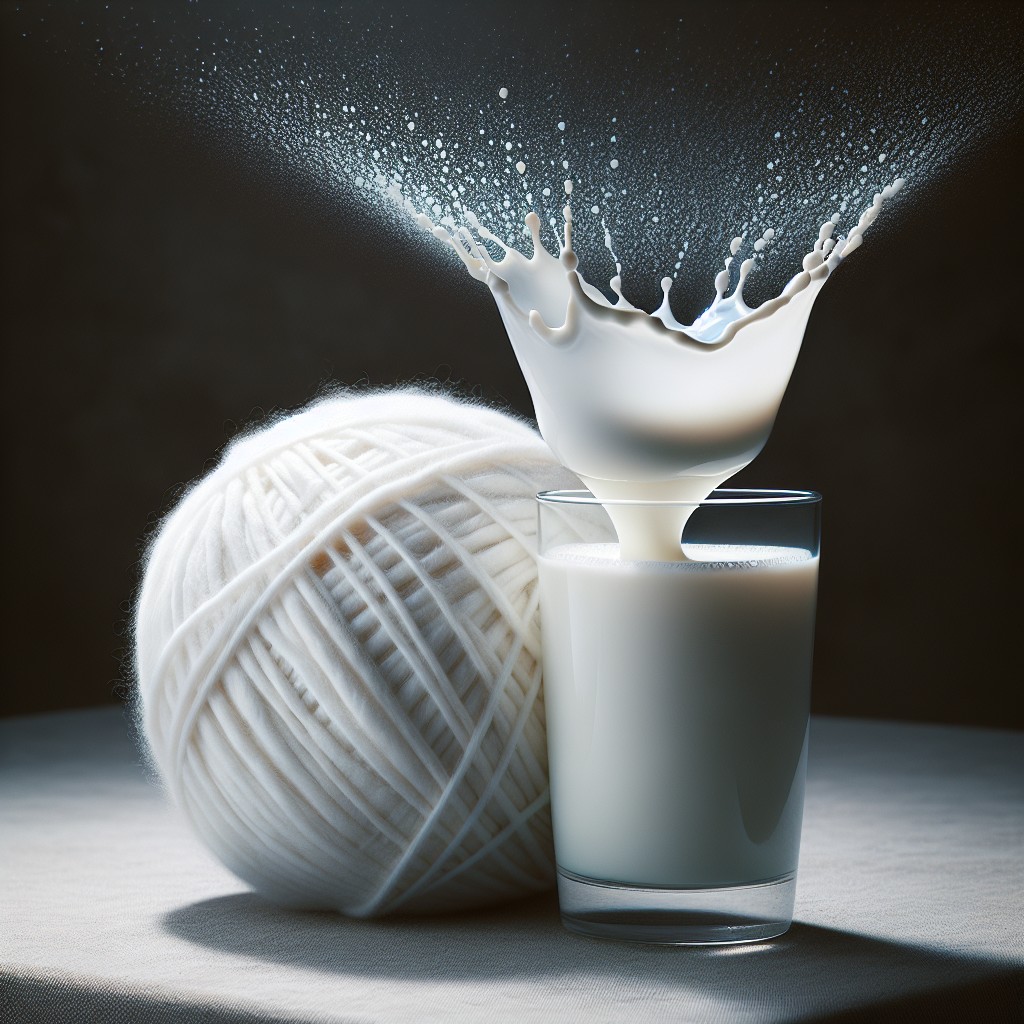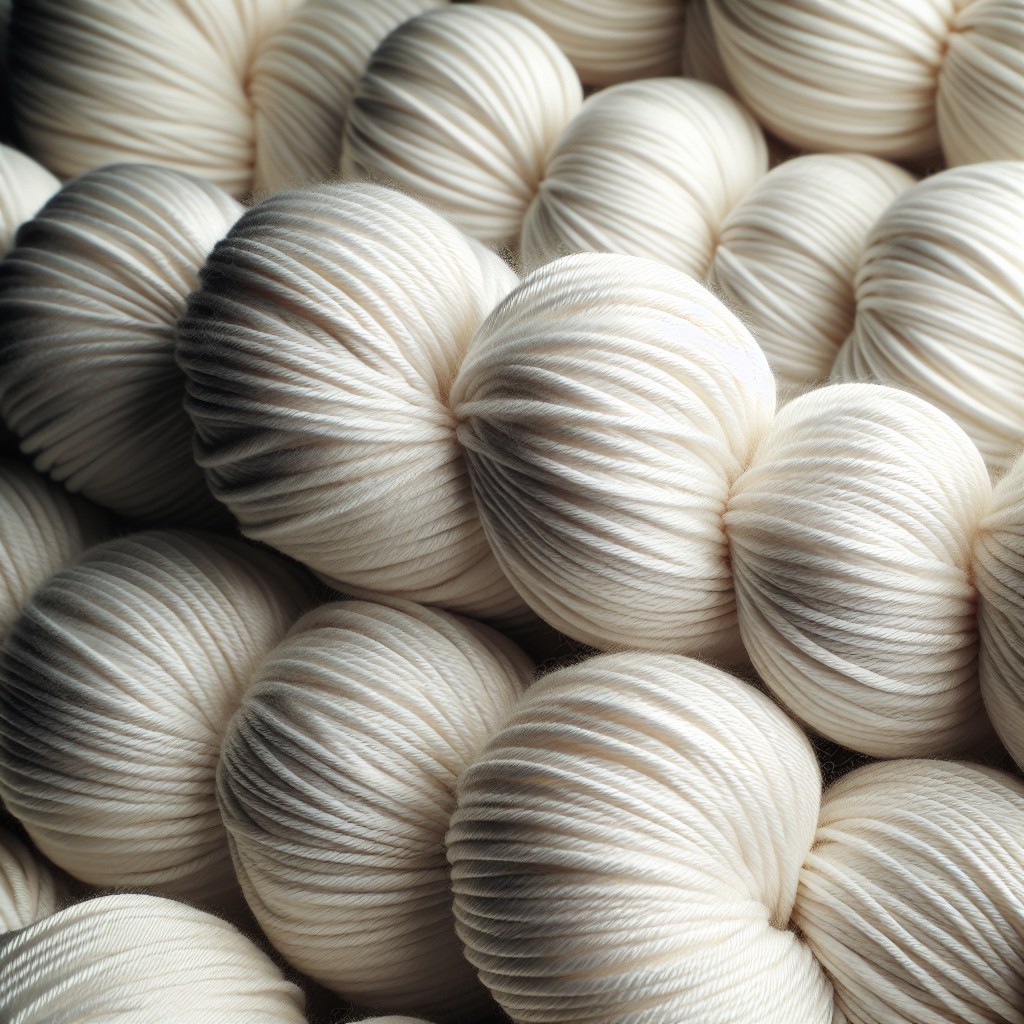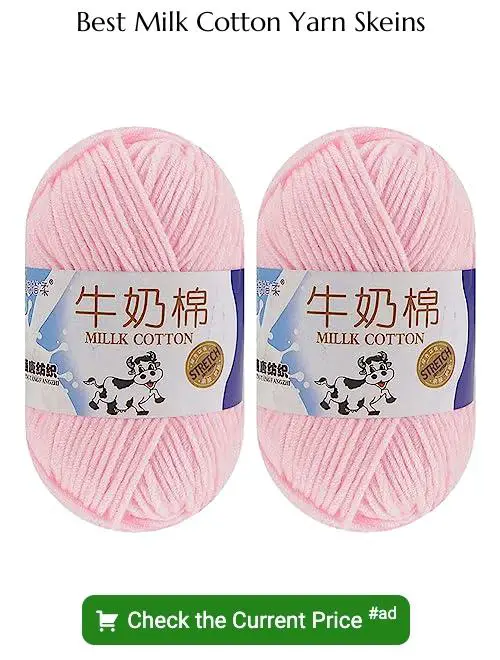Dive into the captivating world of milk cotton yarn, because its unique qualities make it an unparalleled choice for your next craft project.
Milk cotton yarn is an intriguing blend of both milk protein and cotton, producing a soft and durable material ideal for a variety of knitting and crocheting projects. From baby blankets to warm winter scarves and intricately detailed amigurumi, the use of milk cotton yarn adds a touch of luxury and comfort to your creations.
With its hypoallergenic properties and easy care instructions, your projects maintain their freshness and beauty for a longer period. Offering key insights on how to choose, work with, and care for milk cotton yarn, we delve into the particulars which makes this type of yarn a popular choice for crafters.
In this article, you will find everything you need to know about the unique and versatile milk cotton yarn.
Key takeaways:
- Milk cotton yarn is a blend of milk protein and cotton for softness and durability.
- It has hypoallergenic properties and is easy to care for.
- Milk cotton yarn has a luxurious sheen and is highly absorbent.
- It is strong, durable, and has thermal properties.
- Proper care involves mild soap, cold wash, air drying, and low-heat ironing.
Definition of Milk Cotton Yarn

Milk cotton yarn is unique, innovative, and boasts a rich texture due to its unconventional composition. This particular type of yarn is crafted using a blend of casein — a protein derived from milk — and cotton fibers.
The casein provides the strength and durability, while the cotton ensures a soft texture, making it perfect for crafting purposes. The innovative process of making milk cotton yarn grants it exceptional softness that surpasses traditional yarns, earning it a favorable reputation among knitters and crocheters around the world.
The protein structure of the casein fiber also gives the yarn anti-bacterial properties, an added bonus for crafters who use it for items such as baby clothing or blankets.
Why Milk Cotton Yarn Is Named So

Milk cotton yarn is earned its unique name from the unlikely source materials that it’s made from. It’s a blend of milk protein and cotton fiber.
During production, the milk protein is synthesized and spun into fibers which are then blended with cotton fibers. The result is a remarkably soft yarn that carries properties of both cotton and the milk protein.
This makes it an intriguing option for yarn crafts.
Properties and Characteristics of Milk Cotton Yarn

Milk cotton yarn holds a unique appeal due to its distinct properties. Possessing an elegant sheen and an exceptionally soft texture, it takes comfort and luxury in yarn crafts to new heights.
This yarn is hypoallergenic, making it a perfect choice for those with sensitive skin or allergies.
The yarn has a high absorbency level, making it an eco-friendly option for items like dishcloths or towels. Its excellent breathability renders it ideal for baby blankets, clothing items, or cozy winter accessories.
It drapes beautifully, adding to its appeal for fashion items or home decor pieces.
Another noteworthy characteristic of milk cotton yarn is its strength and durability. Despite its luxuriously soft feel, this yarn can withstand significant wear and tear, ensuring your craft creations have a long and vibrant life. It exhibits impressive resistance to pilling, maintaining its overall appearance and texture even after repeated use and washing.
This yarn is also notable for its thermal properties. It naturally regulates temperature, keeping you warm during colder months while remaining comfortably cool in summer. This makes it a favorite among artisans for crafting all-season wearables and home accessories.
Finally, milk cotton yarn offers great stitch definition, showcasing intricate stitch patterns in all their glory. Whether you are a crocheter experimenting with complex stitch techniques or a knitter aiming for simplicity, this yarn will make your creations stand out.
Environmental Impact of Milk Cotton Yarn

Producing milk cotton yarn incorporates environmental consciousness into its process. The first point to note is the use of milk protein in its production, a by-product which otherwise would largely go to waste. By utilizing this, the textile industry helps to reduce waste and promote a circular economy.
Another environmental advantage is the lower water consumption by milk cotton production compared to traditional cotton. This enables us to conserve one of our most precious resources, making milk cotton yarn a more eco-friendly alternative. It’s biodegradable too, breaking down naturally at the end of its life cycle, thereby minimizing landfill impact.
However, as the processing involves a fair bit of energy, this is something to take into account when considering the overall environmental footprint. It’s important to weigh the pros and cons in the context of other yarns and individual crafting needs.
Experience of Wearing Milk Cotton Yarn

As a moisture-absorbing yarn, Milk Cotton provides comfort even to those with sensitive skin. Offering both warmth in colder climates and coolness in warmer weather, it’s a versatile choice for year-round wear. Its superior softness and smoothness set it apart from other yarn types, making any apparel item a joy to wear.
From light summer tops to snugly winter scarves, there’s something undeniably luxurious about the feel of Milk Cotton against the skin.
And let’s not forget styling! With a natural sheen and a spectrum of vibrant colours to choose from, it’s not just comfy – it’s aesthetically pleasing too. Given its lightweight nature, garments made from Milk Cotton yarn also tend to drape exceptionally well, offering a flattering fit for all body types.
In short, there are plenty of reasons why so many people are moving towards incorporating Milk Cotton garments into their wardrobes. It’s about touching luxury with an everyday practicality. It’s safe to say, once you’ve tried it, you may find yourself reaching for it time and time again.
Washing and Care Instructions for Milk Cotton Yarn
Caring for your milk cotton yarn creations deserves special attention. Proper laundering can extend their lifespan and ensure they maintain their softness and lustre.
1. Mild Soap: Avoid using harsh detergents. A gentle, pH-neutral soap will clean without damaging the delicate fibres.
2. Cold Wash: Cold water prevents the yarn from shrinking. Remember to use a gentle cycle if using a washing machine.
3. Avoid Bleach: Bleach can weaken the fibres and fade the colours. Stick to gentle soap.
4. Air Dry: Air drying your milk cotton yarn items is the best choice. Avoid the dryer to keep the structure of the projects intact.
5. Ironing: Use a low-heat setting. High heat can lead to loss of sheen.
6. Storage: Yarn-made items should be stored flat, and away from direct sunlight to prevent damage and fading.
By following these guidelines, you can maintain your work’s pristine condition.
Comparison of Milk Cotton Yarn With Other Yarn Types
Diving into the myriad world of yarn types, one immediately notices the unique qualities of milk cotton. Its silk-like shimmer, inherent softness and remarkable strength set it apart in the crowd of yarns.
For instance, wool yarn, while warm and elastic, lacks the luster and silkiness that milk cotton prides itself on. On the other hand, synthetic options like acrylic can mimic milk cotton’s sheen, but often fall short in capturing the touch-friendly texture, while being notably less breathable.
Traditional cotton yarn, another popular choice, bears a certain kinship with milk cotton. Both come with a reputation for sturdiness and washability. Nevertheless, traditional cotton lacks the gentle sheen and silky smoothness of milk cotton, often feeling rather dull and stiff in comparison.
Linen yarn, characterized by its cool, breathable quality, may win some hearts during the summer months. However, its relatively harsh texture makes milk cotton the clear winner for any project requiring supreme softness.
Bamboo yarn, like milk cotton, has a lovely luster and a silky feel that is pleasing to the touch. However, milk cotton yarn manages to retain more warmth, making it a more versatile choice for year-round use.
Try holding a skein of milk cotton yarn, and it becomes clear: its luxurious touch, appealing look, and wide-ranging versatility are second to none. While all yarns bring something different to the table, milk cotton yarn is an all-rounder that raises the bar.
Contrast Between Milk Cotton Yarn and Acrylic Yarn
Both varieties hold their own in the world of yarn; however, there are clear differences. Milk cotton yarn, made from milk protein and cotton fibers, is naturally hypoallergenic. It’s known for its silky texture, which sets it apart from most fibers. Lighter and breathable, it’s ideal for warmer environments or seasons.
On the other hand, acrylic yarn, made from synthetic fibers, has its advantages, particularly in terms of cost-effectiveness and durability. Its robustness makes it a staple for projects that demand high durability, such as toys and blankets. It’s also more resistant to moth damage, unlike natural fibers.
It’s crucial to note that acrylic has less breathability compared to milk cotton, potentially resulting in a warmer wear. The texture of this type also varies, feeling less soft than the milky counterpart. Hence, when picking your yarn, it all swings back to the project at hand, the budget, and personal preference.
Comparative Softness: Milk Cotton Vs Regular Cotton
In examining softness, milk cotton stands out distinctly from its regular counterpart. The implementation of milk proteins during the creation process contributes to this difference. These proteins adhere to the cotton, lending a silky texture that’s incredibly pleasing to the touch.
Regular cotton, on the other hand, while softer than many synthetic materials, does not possess the same creamy consistency. It’s smooth and cool, of course, optimal for summer wear and acceptable for baby items, but can’t stand up to the distinctively soft and silky nature of milk cotton.
Keep in mind, however, that the variety in textures doesn’t qualify one as superior to the other. Project purpose, wearer’s preference and comfort often dictate the more suitable option. It’s advisable to forecast the product’s end use when making your selection. For example, a plush stuffed toy might benefit from the luxurious feel of milk cotton, while a durable tote bag might need the strength and sturdiness of regular cotton.
Crafting Possibilities With Milk Cotton Yarn
Thanks to its soft texture and finesse, milk cotton yarn is a great option for various types of textile projects. Garments such as lightweight sweaters, baby clothes, and hats are particularly well-suited. Remarkably comfortable, milk cotton yarn is an excellent choice for accessories in direct contact with the skin, including scarves, gloves, and even plush toys.
Crocheting decorative items like dishcloths, coasters or doilies are also attractive uses, due to the vibrant colors often available in milk cotton. For knitting enthusiasts, consider crafting a plush afghan or a cozy washcloth. This yarn can also enrich tapestry weaving projects, adding a touch of softness, and providing a beautiful visual aesthetic.
In home decor crafts, milk cotton shines in creating cushion covers and small rugs. And for those into amigurumi, milk cotton, with its inherent softness and vast color palette, makes for an excellent material for stuffed animals and dolls. Bear in mind, the end result will not only be visually appealing but also incredibly soft to touch.
Ultimately, it enables the creation of a wide variety of elegant pieces, proving its versatility in the world of crafting. Wherever your craft journey leads you, milk cotton yarn is sure to offer delightful results.
Suitability of Milk Cotton Yarn for Crochet
Milk cotton yarn is favored by both beginners and experienced crocheters for its superior texture and ease of handling. It slides smoothly on the hook, making it easy to create consistent stitches and intricate patterns. Offering both softness and durability, it holds up well under tension, unlike some other yarns which may split or fray.
Its evenly spun texture is ideal for crochet stitches, no matter how complex; from simple single crochet to more advanced stitches like a popcorn or Bavarian square. Moreover, it’s hypoallergenic nature makes it an excellent choice for projects such as baby garments, blanket or amigurumi, ensuring comfort for sensitive skin.
However, its drape might not be as fluid as other natural fibers. For projects requiring more drape, such as shawls or tops, blending milk cotton with other fibers might be a viable solution.
You’ll appreciate how beautifully milk cotton enhances your crochet work, lending an attractive, professional finish. Just remember, to ensure long-lasting beauty, use the recommended hook size and follow care instructions closely.
Range of Projects Well-Suited to Milk Cotton Yarn
Milk cotton yarn, with its supersoft texture and durability, can be incredibly versatile in crafting. It is adored by crafters as patterns made with it take on a smooth and almost polished look.
Let’s dive into the variety of projects this plush yarn suits remarkably well:
- Baby Items: Its hypoallergenic nature makes it an excellent choice for baby blankets, booties, and onesies.
- Summer Garments: Lightweight and breathability make it perfect for summer tops, shawls and scarves.
- Home Décor: Its durability makes it suitable for items like cushion covers and throw blankets, which are frequently used.
- Amigurumi: The firm structure it provides helps maintain shape in these small crochet or knit toys.
- Dishcloths: It’s a natural choice as it’s highly absorbent and durable, resisting frequent washing.
The selection of the project depends entirely on the crafter’s preference. However, this super-soft yarn with a glossy finish can make all these projects look more sophisticated and high-end.
Hook Size Recommendations for Milk Cotton Yarn
To achieve optimal stitch tension when working with milk cotton yarn, a specific hook size is recommended. Most commonly, a 4.5mm to 5.5mm crochet hook will work well. However, the filter size can vary based on specific knitting or crocheting patterns.
When selecting a hook, your stitches shouldn’t be too tight, nor too loose. If stitches are too tight, consider a larger hook. On the contrary, if they’re too loose, try a smaller one. Remember, comfort is paramount when crocheting. Using the right hook size ensures your project is pleasing both aesthetically and in terms of durability.
Always be sure to confirm the suggested hook size on the yarn label, as luxury brands may vary. Madelinetosh, for instance, suggests a hook size of 3.5-4mm. In cases such as this, a gauge swatch is an effective way to determine the ideal hook size for your specific project.
By choosing the correct hook for your yarn weight, your craftsmanship will shine and your finished product will have the intended shape and size. Remember, the key is to maintain uniform tension throughout your work, and the right hook size in conjunction with proper technique can make that achievable.
Guidance On Final Yarn Selection
When deciding on your final yarn selection, consider the project you’re undertaking. A soft, warm shawl may benefit from the delicate smoothness of milk cotton yarn, while a structured handbag could require a yarn with more body. Think about the durability needs. Is the item you’re crafting likely to undergo heavy washing or use? High-performance yarns might be more suitable for such projects.
Contemplate drape and texture. While milk cotton yarn offers a plush finish and beautiful drape, other yarn types can provide either a rustic, chunky look or a sleek, refined appearance. The choice entirely depends on the desired end result.
Make sure to evaluate your color needs. While milk cotton yarn comes in an array of hues, the color choice might be more limited when compared against more conventional types of yarn.
Always keep the recipient in mind. If you’re creating for someone with sensitive skin, the hypoallergenic nature of milk cotton yarn could be a perfect fit. Yet, if it’s for someone who prefers easy care items, a different yarn might be the way to go. It’s about matching the yarn qualities to the need of the project and the preference of the receiver.
Where to Purchase Milk Cotton Yarn
There are various avenues to consider when looking for milk cotton yarn. Local knitting and haberdashery stores could stock them, though the range might vary. Larger, dedicated craft stores will often carry a wider selection of brands and colors to suit different project needs.
The online marketplace is an expansive resource for purchasing this type of yarn. Websites such as Etsy, eBay, and Amazon provide a platform for multiple vendors globally, expanding the choice range. Specialized online wool and yarn stores like LoveCrafts and Wool Warehouse offer additional insight into yarn details and specifications, ensuring a better match for your project.
Another excellent place to check is yarn manufacturers’ websites. This direct approach ensures the authenticity of the product, and you can subscribe to notifications about when your favorite colors or weights are restocked.
Always remember to read previous customer reviews for insights into the quality and experience with the vendor before purchase.
Consider these points the next time you are looking to buy milk cotton yarn, ensuring that you get the best-quality yarn for your money.
Possible Substitutes for Milk Cotton Yarn
Inspecting the material label is a key first step in identifying adequate alternatives. Those seeking a similar texture might consider bamboo yarn. It’s soft, eco-friendly, and drapes well, much like our focal fiber.
For crafters favoring lightweight and breathable options, cotton blend yarns prove satisfactory substitutes due to their absorbent nature and relative durability. Particularly, a blend of organic cotton and bamboo is often lauded for its softness, comparable to the tactile appeal of milk cotton.
Acrylic yarn, although a synthetic type, could also serve as a fairly inexpensive alternative. Notably, it mimics milk cotton’s stretchability and durability, making it suitable for a varied array of crafting projects.
Alpaca yarn and Merino wool may also be deemed worthy substitutes, appreciating their luxurious texture and warmth, particularly beneficial for winter wears. However, keep in mind that these options might prove warmer and pricier as compared to milk cotton.
It’s important to note that the ‘perfect’ replacement very much depends on the intended use of the yarn. Whatever the project, rest assured, there are options aplenty to cater to specific needs, even beyond milk cotton.
FAQ
What is a milk cotton yarn?
Milk cotton yarn is a type of yarn made from milk fiber or casein fiber, which is produced using the casein powder found in milk, offering a cotton-like texture and tensility.
What is the difference between cotton and milk cotton?
Cotton is a natural fiber while milk cotton is a blend of cotton and milk fiber, creating a soft, squishy, and smooth yarn.
What is the difference between acrylic and milk cotton yarn?
Acrylic yarn is a less expensive, petroleum-based, machine washable and dryable synthetic fiber, whereas milk cotton yarn is derived from the fibers of the cotton plant.
Is milk cotton yarn good for bags?
Milk cotton yarn, although soft, is not the best choice for bags as 100% cotton yarn is typically recommended due to its greater durability and better stitch definition.
What are some recommended projects for milk cotton yarn?
Milk cotton yarn is ideal for creating delicate baby blankets, plush toys, scarves, mittens, and cozy sweaters.
How does the durability of milk cotton yarn compare to other yarn types?
Milk cotton yarn is generally more resilient and durable than synthetic yarns but less durable than pure cotton or wool yarns.
How to care for finished items made from milk cotton yarn?
Finished items made from milk cotton yarn should be hand washed in cold water with mild soap, and laid flat to dry to maintain their form and style.





